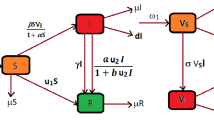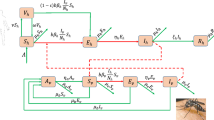Abstract
Isolation and quarantine play important role to control dengue outbreak but much attention has not yet been paid to develop dengue models with these control factors. In this paper, we have developed a \(SEIQR-SEI\) type compartmental dengue model with the effect of isolation. The model has one locally asymptotically stable disease free equilibrium (DFE) point when the basic reproduction number is less than unity. The model without dengue induced death has a globally asymptotically stable DFE point when the corresponding basic reproduction number is less than unity and a globally asymptotically stable endemic equilibrium point when the basic reproduction number is greater than unity. The model exhibits backward bifurcation when the basic production number is equal to one and the first bifurcation coefficient is greater than zero. The key model parameters have been estimated by fitting the model to the dengue outbreak data reported from Singapore during the period 18th week to 53th week,2014. The findings suggest that the total outbreak size reduces by 32.87%, 27.02% and 35.96% respectively when the isolation rate increases from 0 to 0.5, the mosquito biting rate reduces from 1.235 to 1.00 and the vector control rate increases from 0.038 to 0.090. Using sensitivity analysis, we have determined the most sensitive model parameters.







Similar content being viewed by others
References
Guzman, M.G., Harris, E.: Dengue. Lancet 385, 453–465 (2015)
World Health Organization (WHO) (2018) Dengue and severe dengue. Accessed 2 Feb 2018. http://www.who.int/mediacentre/factsheet/fs117/en/
Centres for Disease Control and prevention (CDC): Dengue. http://www.cdc.gov/Dengue/. Page last updated: January 19, 2016 (2016)
Hossain, Md.S., Nayeem, J., Podder Dr, C.: Effect of migratory population and control strategies on the transmission dynamics of dengue fever. J. Appl. Math. Bioinform. 5, 43–80 (2015)
Varatharaj, A.: Encephalitis in the clinical spectrum of dengue infection. Neurology India, 58 (2010)
European Centre for Disease Control and Prevention (ECDC): Sexual transmission of dengue in Spain-18. November, 2019 (2019)
World Health Organisation Report: Dengue hemorrhagic fever, diagnosis, treatment and control. Geneva (1997)
Noisakran, S., Perng, G.C.: Alternative hypothesis on the pathogenesis of dengue hemorrhagic fever (DHF)/dengue shock syndrome (DSS) in dengue virus infection. Exp. Biol. Med. 233(4), 401–408 (2008)
Goh, K.T., Yamazaki, S.: Serological survey on dengue virus infection in Singapore. Trans. R. Soc. Trop. Med. Hyg. 81(4), 687–689 (1987)
Committee on Epidemic Diseases, Singapore Ministry of Health: Dengue surveillance in Singapore, 1998. Epidemiol. News Bull. 25, 1–3 (1999)
Singapore Ministry of Health. Dengue fever/dengue hemorrhagic fever (DF/DHF).In: Communicable Diseases Surveillance in Singapore 2007, pp. 22–33. Ministry of Health, Singapore (2008). https://www.moh.gov.sg
Singapore Ministry of Health. Dengue fever/dengue hemorrhagic fever (DF/DHF). In: Communicable Diseases Surveillance in Singapore 2013, pp. 52–65. Ministry of Health, Singapore (2014). https://www.moh.gov.sg
Hapuarachchi, H.C., Koo, C., Kek, R.: Intra-epidemic evolutionary dynamics of a dengue virus type 1 population reveal mutant spectra that correlate with disease transmission. Sci. Rep. 6, 22592 (2016)
Hapuarachchi, H.C., Koo, C., Rajarethinam, J.: Epidemic resurgence of dengue fever Singapore in 2013–2014: a virological and entomological perspective. BMC Infect. Dis. 16, 1–13 (2016)
Loo, Y.Y., Billa, L., Singh, A.: Effect of climate change on seasonal monsoon in Asia and its impact on the variability of monsoon rainfall in Southeast Asia. Geosci. Front. 6, 817–823 (2015)
Ooi, E.-E., Goh, K.-T., Gubler, D.J.: Dengue prevention and 35 years of years of vector control in Singapore. Emerg. Infect. Dis. 12, 887–893 (2006)
World Health Organization (WHO): Factsheet no.117. Dengue and severe dengue (2016). http://www.who.int/mediacentre/factsheet/fs117
Keeling, M.J., Rohani, P.: Modelling Infectious Diseases I Humans and Animals. Princeton University Press, Princeton (2011)
Mutta, J.M., Wang, F.B., Vidya, N.K.: Modelling malaria and typhoid fever co-infection dynamics. Math. Biosci. 264, 128–144 (2015)
Vidya, N.K.: Modelling the epidemic spread of H1N1 influenza outbreak in rural university town. Epidemiol. Infect. 143, 1610–1620 (2015)
Biswas, S.K., Ghosh, U., Sarkar, S.: Mathematical model of zika virus dynamics with vector control and sensitivity analysis. Infect. Dis. Model. 5, 23–41 (2020)
Focks, D.A., Daniels, E., Haile, D.G., Keeling, J.E.: A simulation model of the epidemiology of urban dengue fever; literature analysis, model development, preliminary validation, and samples simulation results. Am. J. Trop. Med. Hyg. 53, 489–506 (1995)
Esteva, L., Vargas, C.: Influence of vertical and mechanical transmission on the dynamics of dengue disease. Math. Biosci. 167, 51–64 (2000)
Andraud, M., Hens, N., Beutels, P.: A simple periodic-forced model for dengue fitted to incidence data in Singapore. Math. Biosci. 244, 22–28 (2013)
Katri, P.: Modeling the transmission dynamics of the dengue virus. Ph.D. Thesis. University of Miami. Open Access Dissertations (2010). http://scholarlyrepository.miami.edu
Stoddard, S.T., Wearing, H.J., Reiner, R.C.: Long-term and seasonal dynamics of Dengue in Iquitos. Peru. Plos Negl Trop Dis 8(7), e3003 (2014)
Chowell, G., Fuentes, R., Olea, A., Aguilera, X., Nesse, H., Hyman, J.M.: The basic reproduction number and effectiveness of reactive intervention during dengue epidemic: the 2002 dengue outbreak in Easter Island, Chile. Math. Biosci. Eng. 10, 1455–1474 (2013)
Robert, M.A., Christofferson, R.C., Silva, N.J.B., Vasquez, C., Mores, C.N., Wearing, H.J.: Modelling mosquito-borne disease spread in U.S. urbanized areas: the case of dengue in Miami. PLOS ONE 11(8), e0161365 (2016)
Feng, Z., Velasco-Hernandez, J.X.: Competitive exclusion in a vector-host model for the dengue fever. J. Math. Biol. 35, 523–544 (1997)
Wearing, H.J., Rohani, P.: Ecological and immunological determinants of dengue epidemics. Proc. Natl. Acad. Sci. U.S.A. 103, 11802–11807 (2006)
Atkinson, M.P., Zheng, S., Alphey, N., Alphey, L.S., Coleman, P.G., Wein, L.M.: Analyzing the control of mosquito-borne diseases by a dominant lethal genetic system. Proc. Natl. Acad. Sci. U.S.A. 104(22), 9540–9545 (2007)
Pinho, S.T.R., Ferreira, C.P., Esteva, L.: Modelling the dynamics of dengue of real epidemics. Phil. Trans. R. Soc. A 368, 5679–5693 (2010)
Cho, D.L., Longini, I.M., Jr., Halloran, M.E.: The effects of vector movement and distribution in a mathematical model of dengue transmission. PLOS ONE 8(10), e76044 (2013)
Pongsumpun, P., Tang, I.-M., Wongvanich, N.: Optimal control of the dengue dynamical transmission with vertical transmission. Adv. Differ. Equ. 176 (2019)
Lakshmikantham, V., Leela, S., Martynyuk, A.A.: Stability Analysis of Nonlinear System. Marcel Dekker. Inc., New York (1989)
Hethcote, H.W.: The mathematics of infectious diseases. SIAM Rev. 42(4), 599–653 (2000)
Van den Driessche, P., Watmough, J.: Reproduction numbers and sub-threshold endemic equilibria for compartmental models of disease transmission. Math. Biosci. 180, 29–48 (2002)
Shuai, Z., Vanden Driessche, P.: Global stability of infectious disease models using Lyapunov functions. SIAM J. Appl. Math. 73(4), 1513–1532 (2013)
LaSalle, J.P.: The Stability of Dynamical System: CBMS-NSF Regional Conference Series in Applied Mathematics, vol. 25. SIAM, Philadelphia (1986)
Castillo-Chavez, C., Song, B.: Dynamical model of tuberculosis and their applications. Math. Biosci. Eng. 1(2), 361–404 (2004)
Chitnis, N., Hyman, J.M., Cushing, J.M.: Determining important parameters in the spread of malaria through the sensitivity analysis of a mathematical model. Bull. Math. Biol. 70(5), 1272–1296 (2008)
Weekly number of dengue and dengue haemarrhagic fever cases from 2014 to 2018, Ministry of Health, Singapore, data.gov.sg/dataset
Saad-Roy, C.M., Ma, J., Van den Driessche, P.: The effect of sexual transmission on Zika virus dynamics. J. Math. Biol. 77, 1917–1941 (2018)
Garba, S.M., Gumel, A.B., Bakar, M.R.A.: Backward Bifurcation in Dengue transmission Dynamics. Math. Biosci. 215(1), 11–25 (2008). https://doi.org/10.1016/j.mbs.2008.05.002
Ojo, M.M., Gbadamosi, B., Olukayode, A., Oluwaseun, O.: Sensitivity analysis of dengue model with saturated incidence rate. Open Access Lib. J. (2018). https://doi.org/10.4236/oalib.1104413
Liu, T., Zhu, G., He, J., Song, T., Zhang, M., Lin, H., Xiao, J., Zeng, W., Li, X., Li, Z., Xie, R., Zhong, H.: Early rigorous control interventions can largely reduce dengue outbreak magnitude: experience from Chaozhou, China. BMC Public Health 18, 90 (2018)
Acknowledgements
The authors gratefully acknowledge the constructive comments of the referees concerning this paper.
Author information
Authors and Affiliations
Contributions
SKB: Formulated the model, performed computations and numerical simulations; SS: Supervise overall; UG: Formulated the model and help in different stages of analytical and numerical computations.
Ethics declarations
Conflict of interest
The authors declare that there are no conict of interests with publication of this work and no nancial support from any agency.
Ethical approval
This article does not contain any with human participants or animal performed by any of the authors.
Additional information
Publisher's Note
Springer Nature remains neutral with regard to jurisdictional claims in published maps and institutional affiliations.
Rights and permissions
About this article
Cite this article
Biswas, S.K., Sarkar, S. & Ghosh, U. The Role of Isolation and Vector Control in the Prevention of Dengue: A Case Study of 2014 Dengue Outbreak in Singapore. Int. J. Appl. Comput. Math 7, 224 (2021). https://doi.org/10.1007/s40819-021-01167-3
Accepted:
Published:
DOI: https://doi.org/10.1007/s40819-021-01167-3
Keywords
- Dengue model with isolation
- Stability analysis
- Backward bifurcation
- Sensitivity analysis
- Parameter estimation
- Prevention measure




